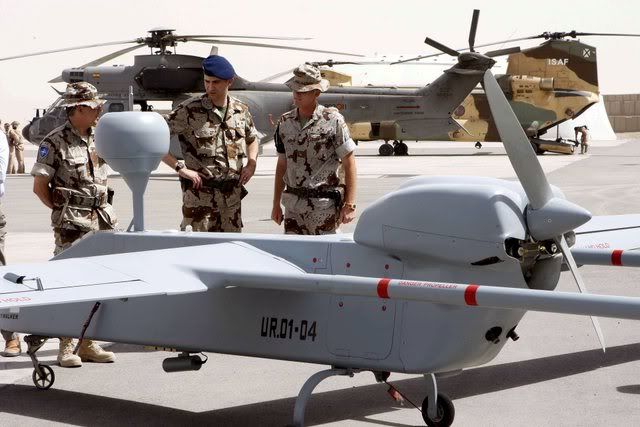DATE:12/06/08
SOURCE:Flight International
USAF to use GPS weapons with Reaper UAV
By Craig Hoyle
The US Air Force plans to equip its General Atomics MQ-9 Reaper unmanned air vehicles with GPS-guided weapons in the near future, and is also reassessing its future acquisition mix with the company's smaller MQ-1 Predator A.
The air force last month conducted the first test releases of 226kg (500lb) GPS-guided GBU-49 bombs from a Reaper over the US Navy's China Lake weapons range in California, culminating with a "ripple" release of three GPS stores and one laser-homing round.
"We hope to integrate that [operationally] soon," says Col Chris Chambliss, commander of the USAF's Predator and Reaper-equipped 432nd Air Expeditionary Wing at Creech AFB, Nevada, adding:
"It takes us out of the visible spectrum." However, the service is still assessing its rules of engagement to see whether MQ-9 operators could perform strikes using targeting information acquired using the type's General Atomics Lynx synthetic aperture radar.
Since deploying the "hunter-killer" type over Afghanistan last October, Chambliss says the Reaper has frequently employed its weapons - currently comprising two 226kg laser-guided bombs and four AGM-114 Hellfire air-to-surface missiles.
"That's one of the reasons we wanted to get the Reaper into the fight so early," he adds.
USAF Reapers had flown more than 320 sorties totalling 2,400 flight hours in Afghanistan by early May, according to the service, and Chambliss confirms: "We're on a pretty much 24h schedule."
Chambliss says the air force is also now assessing its long-term fleet strategy for the Reaper, with 60 air vehicles currently planned for acquisition, alongside more Predator As. "We're trying to reveal whether that's right," he says.
In addition to its increased weapons load and greater altitude and endurance characteristics, the Reaper - which is also operated from Creech by the UK Royal Air Force's 39 Sqn - also brings improved reliability and maintainability, in part thanks to its use of a commercial turboprop. "The engine problems we have with Predator we're not seeing with the Reaper," says Chambliss.
Predator milestones
SOURCE:Flight International
USAF to use GPS weapons with Reaper UAV
By Craig Hoyle
The US Air Force plans to equip its General Atomics MQ-9 Reaper unmanned air vehicles with GPS-guided weapons in the near future, and is also reassessing its future acquisition mix with the company's smaller MQ-1 Predator A.
The air force last month conducted the first test releases of 226kg (500lb) GPS-guided GBU-49 bombs from a Reaper over the US Navy's China Lake weapons range in California, culminating with a "ripple" release of three GPS stores and one laser-homing round.
"We hope to integrate that [operationally] soon," says Col Chris Chambliss, commander of the USAF's Predator and Reaper-equipped 432nd Air Expeditionary Wing at Creech AFB, Nevada, adding:
"It takes us out of the visible spectrum." However, the service is still assessing its rules of engagement to see whether MQ-9 operators could perform strikes using targeting information acquired using the type's General Atomics Lynx synthetic aperture radar.
Since deploying the "hunter-killer" type over Afghanistan last October, Chambliss says the Reaper has frequently employed its weapons - currently comprising two 226kg laser-guided bombs and four AGM-114 Hellfire air-to-surface missiles.
"That's one of the reasons we wanted to get the Reaper into the fight so early," he adds.
USAF Reapers had flown more than 320 sorties totalling 2,400 flight hours in Afghanistan by early May, according to the service, and Chambliss confirms: "We're on a pretty much 24h schedule."
Chambliss says the air force is also now assessing its long-term fleet strategy for the Reaper, with 60 air vehicles currently planned for acquisition, alongside more Predator As. "We're trying to reveal whether that's right," he says.
In addition to its increased weapons load and greater altitude and endurance characteristics, the Reaper - which is also operated from Creech by the UK Royal Air Force's 39 Sqn - also brings improved reliability and maintainability, in part thanks to its use of a commercial turboprop. "The engine problems we have with Predator we're not seeing with the Reaper," says Chambliss.
Predator milestones




